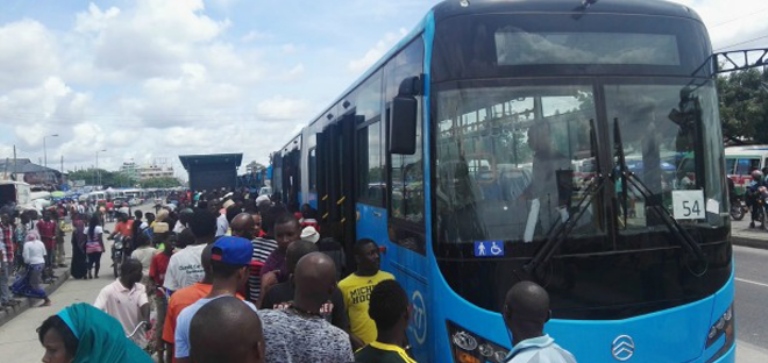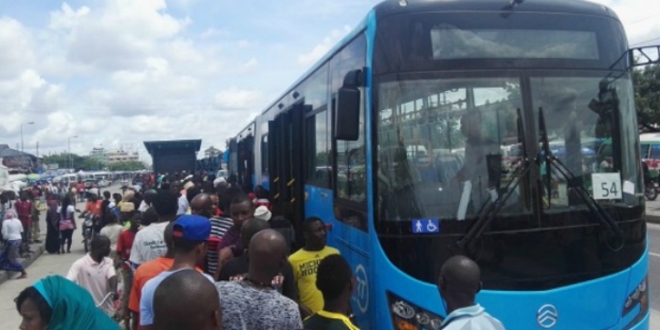Geza Ulole
JF-Expert Member
- Oct 31, 2009
- 59,302
- 79,726
Rapid Transit system eyes cleaner energy infrastructure, fleet
February 4, 2022

04Feb 2022
Francis Kajubi
Dar es Salaam
Business
The Guardian
Rapid Transit system eyes cleaner energy infrastructure, fleet
THE Dar es Salaam Rapid Transit Agency (DART) and Tanzania Petroleum Development Corporation (TPDC) are in talks to invest in cleaner energy infrastructure, that will enable the urban transport agency to start using environmental friendly energy.

It is planned by 2023; DART fleets operators will be using natural gas to run buses, as part of mitigating the impact of fossil fuel to climate. Tanzania has an estimated natural gas reserve of 57 trillion cubic feet.
Currently, all buses operating on DART infrastructure corridors are using diesel as their main source of energy, and officials say one bus consumes at least 1.7 litres, which is not cost effective and environment friendly.
The project will involve the construction of gas filling stations, which will specifically serve DART operators, to alternate diesel.
Speaking to Property Watch earlier this week in Dar es Salaam, DART Acting Director of Operations and Infrastructure Management, Engineer Ahmed Wamala, said talks started since mid-last year, although he did not give more details on the targeted project.
“I can’t go further into details for now, but it is true that we are negotiating with TPDC for such a clean energy initiative for buses operating within DART corridors,” said Wamala.
According to him, the agency is even eager to see that phase two of the project, connecting Magomeni to Mbagala suburb is being modernized to cleaner energy infrastructure.
“We are considering procuring 95 new articulated buses to add on the current 210 buses in operation. In the wake of climate change effects, it’s logical to have some of these buses made of clean energy systems such as liquefied natural gas to reduce carbon emission,” he added.
However, Wamala noted that the agency plans of engaging more players in the central business district project.
The agency is intending to engage commuter bus operators in the project by allowing them to operate in all feeder roads connected to the main trunks corridor.
“The project is designed with many feeder roads connecting the trunks from different streets of the city. This part of the project will be left for commuter bus operators but under special conditions such as having buses with special certified standards agreed by DART. Commuter bus operators will have to form a shareholding company which they will run jointly and own shares,” he explained.
He said that more new service providers are mostly likely to join the project as the agency continues to extend the BRT network.
According to him, UDA-RT owns 51 percent in shares of the project and the government through Dar Rapid Transit Agency (DART) owns the remaining 49 percent.
“As we speak the BRT system moves almost 180,000 passengers a day with 210 buses from 76,000 passengers in 2016 when the project had only 140 buses,” said Wamala.
Commenting on the new initiative, Sarah Ngoy, Executive Director Forum on Climate Change (Forum CC) said the government initiative through DART is in line with global strategies to reduce global warming by reducing greenhouse gas emissions generated by fossil fuels, coal and transportation activities.
According to her, fuel and diesel combustion emits carbon dioxide, greenhouse gases, into the atmosphere.
The concentration of carbon dioxide (CO2) and other pollutants such as methane (CH4), nitrous oxide (N2O), and hydro fluorocarbons (HFCs) causes global warming.
Global warming, she asserted, results in climate change impacts that we are already seeing today such as increase in heat, prolonged drought, seasonal floods and diseases.
“The more people travel using transportation that involves burning diesel and petrol the more we contribute to greenhouse gas emissions. Clean energies are therefore a remedy to this tragedy,” said Ngoy.
According to Climate change and global warming analysis 2021 done by NASA and the National Oceanic and Atmospheric Administration (NOAA), Earth’s global average surface temperature in 2021 tied 2018 as the sixth-warmest year on record.
The analysis that came out mid-January 2022 reads that global temperatures in 2021 were 0.85 degrees Celsius (1.5 degrees Fahrenheit) above the average for NASA’s baseline period, according to scientists at NASA’s Goddard Institute for Space Studies (GISS).
The analysis asserts that the long-term global warming trend is largely due to human activities that have increased emissions of carbon dioxide and other greenhouse gases into the atmosphere.
“Science leaves no room for doubt: Climate change is the existential threat of our time. Eight of the top ten warmest years on our planet occurred in the last decade, an indisputable fact that underscores the need for bold action to safeguard the future of our country and all of humanity,” said NASA Administrator Bill Nelson in a statement to the press mid-January 2022.
NASA uses the period from 1951-1980 as a baseline to compare how global temperatures change over time. In the East African region, Kenya has emerged as the first country to have clean energy technology vehicles.
A Swedish-Kenyan company, Opibus, has recently introduced the first African-designed and manufactured electric bus in Kenya with the aim of bringing clean energy to public transportation. Opibus, Kenya’s first company to make electric motorcycles plans to launch the bus commercially in a few months and bring it to markets across Africa by 2023.
Rapid Transit system eyes cleaner energy infrastructure, fleet
THE Dar es Salaam Rapid Transit Agency (DART) and Tanzania Petroleum Development Corporation (TPDC) are in talks to invest in cleaner energy infrastructure, that will enable the urban transport agency to start using environmental friendly energy.